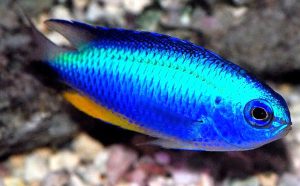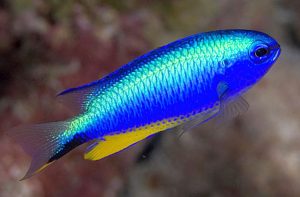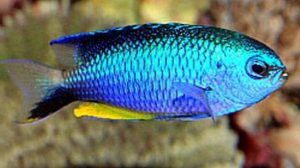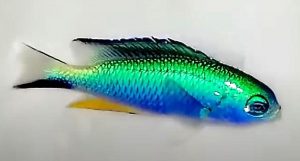The Neon Damselfish (Pomacentrus Alleni) known to tropical fish keeping enthusiasts as Allen’s Damselfish, Allen’s Pomacentrus, Blue Star Damsel, Alleni Damsel, Electric Blue Damsel, Yellow Belly Damsel, and Andaman Damselfish is found in the Pacific Ocean in Australia, Indonesia, the Phillippines, Japan, Taiwan, the Similan Islands off of Thailand, and Vietnam.
In the Pacific Islands they are found around Hawaii and in the Indian Ocean they are found in the Andaman Sea, Australia, Indonesia, and Sri Lanka.
Although there are about a half dozen species recognized by tropical fish keeping enthusiasts as Neon Damselfish; Pomacentrus Alleni
is a distinctive species reported primarily from the Andaman Sea. It is often mistakenly identified as Pomacentrus similis.
Pomacentrus coelestis, P. similis, P. auriventris, P. cf caeruleus, P. caeurleus, P. micronesicus, and some unrecognized species are all referred to as Neon Damselfish.
Juvenile Pomacentrus Alleni are usually found swimming in large schools over soft corals in the reefs and lagoons of their range at depths between 6 to 70 feet, where they feed on zooplankton, and benthic algae. Adult Pomacentrus Alleni prefer schooling in large and small schools over other areas of the reef, not necessarily soft corals.
Several species of “Neon Damselfish” are frequently encountered away from pristine coral reefs in favor of turbid habitats rich in open, rocky terrain and in their preferred niche, they are an ecologically dominant species that frequently form vast shoals numbering into the thousands.
Neon Damselfish (Pomacentrus Alleni) have a striking electric blue to blue/green body color that blends into the yellow anal fin at the belly of the fish, with black on the lower caudal lobe, and a partially black dorsal fin. Although there are no obvious external differences between sexes, males are somewhat brighter in color to females during breeding.
The Neon Damselfish is best housed in groups of at least 5 individuals in either a reef or FOLR aquarium of at least 55 gallon capacity, with a sand or finely crushed gravel substrate and plenty of mature live rock arranged into crevices, caves, and overhangs for them to shelter among. Pomacentrus Alleni have a penchent for digging into the sand but will not disturb corals or invertebrates in a reef tank. They show their colors best in strong lighting as is found in a reef environment.
Alleni Damselfish are one of the more peaceful damselfish species that do well in FOLR tanks in groups of 7 or more individuals with peaceful, non aggressive tankmates. In large groups, they “flash” their brilliant colors as they compete with each other for dominance. They are very shy and docile, and will lose their electric blue color and turn a pale brownish color when afraid or threatened by aggressive tankmates.
In large tanks with plenty of live rockwork hiding spaces and swimming area, larger odd numbered shoals of 9 plus juvenile Neon Damselfish will peacefully coexist with other similar species or similarly sized species. Small groups are known to suffer fatalities.
Avoid keeping Neon Damselfish with any really docile species such as firefish and cardinalfish; and never house them with more aggressive species.
Alleni Damselfish have not been successfully bred in an aquarium environment.
Neon Damselfish form distinct pairs when breeding. After a short mating “dance” the tiny adhesive eggs, numbering up to 1000 or more, are deposited in a cave or on the substrate by the female. After the male fertilizes the eggs, he will guard and aerate the eggs until they hatch out, in about 3 or 4 days. In their natural habitat, the tiny larvae drift with the current as plankton for about three weeks, feeding on zooplankton and phytoplankton before settling to the bottom as a partially developed damsel. A single male will often mate with several females during the breeding season.
In their natural habitat, Neon Damselfish feed on algae, zooplankton, and occasionally benthic organisms. In an aquarium environment they will eagerly accept live fortified brine shrimp, finely chopped fresh or frozen meaty foods like squid, fish flesh, shrimp, clam, Mysis
, etc. and Spirulina flakes
or pellets two to three times a day.
Neon Damselfish (Pomacentrus Alleni) are occasionally available to tropical fish keeping enthusiasts in specialty fish stores and from online wholesalers, trans shippers, and retailers at prices varying from $14.99 to $37.99 at a purchase size of 3/4″ to 2-1/2″.
Minimum Tank Size: 55 gallons
Aquarium Type: Reef or FOLR
Care Level: Easy
Temperament: Semi Aggressive
Aquarium Hardiness: Very Hardy
Water Conditions: 72-84°F, dKH 8 to 12 , pH 8.1 – 8.4, sg 1.020-1.026
Max. Size: 2.5″
Color Form: Blue, Green, Yellow
Diet: Omnivore
Compatibility: Reef Safe
Origin: Indo Pacific Ocean, Andaman Sea, Fiji
Family: Pomacanthidae
Lifespan: 5 years
Aquarist Experience Level: Beginner






